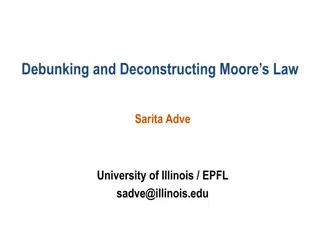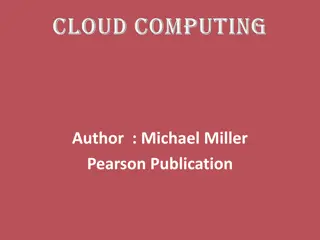Understanding Number Systems in Digital Computing
Explore the decimal, binary, octal, and hexadecimal numbering systems essential for digital computing. Learn to convert between these systems, grasp terms like bit, byte, and word, and perform basic binary arithmetic operations. Visual aids and explanations make complex concepts easily understandable.
Download Presentation

Please find below an Image/Link to download the presentation.
The content on the website is provided AS IS for your information and personal use only. It may not be sold, licensed, or shared on other websites without obtaining consent from the author. Download presentation by click this link. If you encounter any issues during the download, it is possible that the publisher has removed the file from their server.
E N D
Presentation Transcript
Number Systems After completing this chapter, you will be able to: Define the decimal, binary, octal, and hexadecimal numbering systems and be able to convert from one numbering or coding system to another Define the terms bit, byte, word, least significant bit (LSB), and most significant bit (MSB) as they apply to binary memory locations Add, subtract, multiply, and divide binary number
6.1 Decimal System Knowledge of different number systems and digital codes is quite useful when working with almost any type of digital computer. This is true because a basic requirement of these devices is to represent, store, and operate on numbers. In general, computer work on binary numbers in one form or another; these are used to represent various codes or quantities. The decimal system, which is most common to us, has a base of 10. The radix or base of a number system determines the total number of different symbols or digits used by that system. For instance, in the decimal system, 10 unique numbers or digits i.e., the digits 0 through 9 are used: the total number of symbols is the same as the base, and the symbol with the largest value is 1 less than the base.
The value of a decimal number depends on the digits that make up the number and the place value of each digit. A place (weight) value is assigned to each position that a digit would hold from right to left. In the decimal system the first position, starting from the rightmost position, is 0; the second is 1; the third is 2; and so on up to the last position. The weighted value of each position can be expressed as the base (10 in this case) raised to the power of the position.For the decimal system then, the position weights are 1, 10, 100, 1000, and so on. Figure 6.1 illustrates how the value of a decimal number can be calculated by multiplying each digit by the weight of its position and summing the results.
6.2 Binary System The binary system uses the number 2 as the base. The only allowable digits are 0 and 1. With digital circuits it is easy to distinguish between two voltage levels (i.e., +5 V and 0 V), which can be related to the binary digits 1 and 0 (Figure 6.2). Therefore, the binary system can be applied quite easily to computer systems. Since the binary system uses only two digits, each position of a binary number can go through only two changes, and then a 1 is carried to the immediate left position.
Table 6.1 shows a comparison among four common number systems: decimal (base 10), octal (base 8), hexadecimal (base 16), and binary (base 2). Note that all numbering systems start at zero. The decimal equivalent of a binary number can be determined in a manner similar to that used for a decimal number. This time the weighted values of the positions are 1, 2, 4, 8, 16, 32, 64, and so on. The weighted value, instead of being 10 raised to the power of the position, is 2 raised to the power of the position.
Figure 6.3 illustrates how the binary number 10101101 is converted to its decimal equivalent: 173. Each digit of a binary number is known as a bit. In a processor-memory element consists of hundreds or thousands of locations. These locations, or registers, are referred to as words. Each word is capable of storing data in the form of binary digits, or bits. Bits can also be grouped within a word into bytes. A group of 8 bits is a byte, and a group of 2 or more bytes is a word.Figure 6.4 illustrates a 16-bit word made up of 2 bytes. The least significant bit (LSB) is the digit that represents the smallest value, and the most significant bit (MSB) is the digit that represents the largest value. A bit within the word can exist only in two states: a logical 1 (or ON) condition, or a logical 0 (or OFF) condition.
To convert a decimal number to its binary equivalent, we must perform a series of divisions by 2. Figure 5.5 illustrates the conversion of the decimal number 47 to binary. We start by dividing the decimal number by 2. If there is a remainder, it is placed in the LSB of the binary number. If there is no remainder, a 0 is placed in the LSB. The result of the division is brought down and the process is repeated until the result of successive divisions has been reduced to 0.
6.3 Negative Numbers If a decimal number is positive, it has a plus sign; if a number is negative, it has a minus sign. In binary number systems, such as computers, it is not possible to use positive and negative symbols to represent the polarity of a number. One method of representing a binary number as either a positive or negative value is to use an extra digit, or sign bit, at the MSB side of the number. In the sign bit position, a 0 indicates that the number is positive, and a 1 indicates a negative number (Table 6-2)
Another method of expressing a negative number in a digital system is by using the complement of a binary number. To complement a binary number, change all the 1s to 0s and all the 0s to 1s. This is known as the 1 s complement form of a binary number. For example, the 1 s complement of 1001 is 0110. The most common way to express a negative binary number is to show it as a 2 s complement number. The 2 s complement is the binary number that results when 1 is added to the 1 s complement. This system is shown in Table 6-3. A zero sign bit means a positive number, whereas a 1 sign bit means a negative number. Using the 2 s complement makes it easier for the computer to perform mathematical operations. The correct sign bit is generated by forming the 2 s complement.
The computer knows that a number retrieved from memory is a negative number if the MSB is 1. Whenever a negative number is entered from a keyboard, the computer stores it as a 2 s complement. What follows is the original number in true binary followed by its 1 s complement, its 2 s complement, and finally, its decimal equivalent 6.4 Octal System To express the number in the binary system requires many more digits than in the decimal system. Too many binary digits can become cumbersome to read or write. To solve this problem, other related numbering systems are used. The octal numbering system, a base 8 system, is used because 8 data bits make up a byte of information that can be addressed. Octal is a convenient means of handling large binary numbers
As shown in Table 6-4, one octal digit can be used to express three binary digits. As in all other numbering systems, each digit in an octal number has a weighted decimal value according to its position. Figure 6.6 illustrates how the octal number 462 is converted to its decimal equivalent: 306.
Octal converts easily to binary equivalents. For example, the octal number 462 is converted to its binary equivalent by assembling the 3-bit groups, as illustrated in Figure 6.7.
6.5 Hexadecimal System The hexadecimal (hex) numbering system is used in programmable controllers because a word of data consists of 16 data bits, or two 8-bit bytes. The hexadecimal system is a base 16 system, with A to F used to represent decimal numbers 10 to 15 (Table 6.5). The hexadecimal numbering system allows the status of a large number of binary bits to be represented in a small space, such as on a computer screen. The techniques used when converting hexadecimal to decimal and decimal to hexadecimal are the same as those used for binary and octal. To convert a hexadecimal number to its decimal equivalent, the hexadecimal digits in the columns are multiplied by the base 16 weight, depending on digit significance.
Figure 6.6 illustrates how the conversion would be done for the hex number 1B7
Hexadecimal numbers can easily be converted to binary numbers. Conversion is accomplished by writing the 4-bit binary equivalent of the hex digit for each position, as illustrated in Figure 6.7
6.6 Binary Arithmetic Mathematical operations include addition, subtraction, multiplication, and division. Binary addition follows rules similar to decimal addition. When adding with binary numbers, there are only four conditions that can occur: The first three conditions are easy because they are like adding decimals, but the last condition is slightly different. In decimal, 1 + 1 = 2. In binary, a 2 is written 10. Therefore, in binary, 1 + 1 = 0, with a carry of 1 to the next most significant place value. When adding larger binary numbers, the resulting 1s are carried into higher-order columns, as shown in the following examples.
In arithmetic functions, the initial numeric quantities that are to be combined by subtraction are the minuend and subtrahend. The result of the subtraction process is called the difference, represented as: To subtract from larger binary numbers, subtract column by column, borrowing from the adjacent column when necessary. Remember that when borrowing from the adjacent column, there are now two digits, i.e., 0 borrow 1 gives 10.
Binary numbers can also be negative. The procedure for this calculation is identical to that of decimal numbers because the smaller value is subtracted from the larger value and a negative sign is placed in front of the result.
There are other methods available for doing subtraction: 1 s complement 2 s complement The procedure for subtracting numbers using the 1 s complement is as follows: Step 1 Change the subtrahend to 1 s complement. Step 2 Add the two numbers. Step 3 Remove the last carry and add it to the number (end-around carry) When there is a carry at the end of the result, the result is positive. When there is no carry, we take the 1 s complement of the result is and a minus sign has to be placed in front of it.
For subtraction using the 2s complement, the 2 s complement is added instead of subtracting the numbers. In the result, if the carry is a 1, then the result is positive; if the carry is a 0, then the result is negative and requires a minus sign.
REVIEW QUESTIONS 1. Convert each of the following binary numbers to decimal numbers: a. 10 b. 100 c. 111 d. 1011 e. 1100 f. 10010 g. 10101 h. 11111 i. 11001101 j. 1110001 2. Convert each of the following decimal numbers to binary numbers: a. 7 b. 19 c. 28 d. 46 e. 57 f. 86 g. 94 h. 112 i. 148 j. 230
3. Convert each of the following octal numbers to decimal numbers: a. 36 b. 104 c. 120 d. 216 e. 360 f. 1516 4. Convert each of the following octal numbers to binary numbers: a. 74 b. 130 c. 250 d. 1510 e. 2551 f. 2634 5. Convert each of the following hexadecimal numbers to decimal numbers: a. 5A b. C7 c. 9B5 d. 1A6 6. Convert each of the following hexadecimal numbers to binary numbers: a. 4C b. E8 c. 6D2 d. 31B
10. Express the decimal number 18 in each of the following number codes: a. Binary b. Octal c. Hexadecimal 7. Add the following binary numbers: a. 110 + 111 b. 101 + 011 c. 1100 + 1011 8. Subtract the following binary numbers: a. 1101 101 b. 1001 110 c. 10111 10010 9. Convert each piece of binary information to the appropriate hexadecimal code a. 0001 1111 b. 0010 0101 c. 0100 1110 d. 0011 1001

























